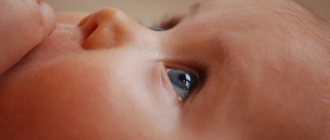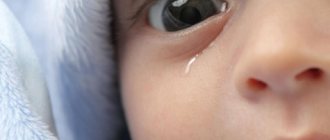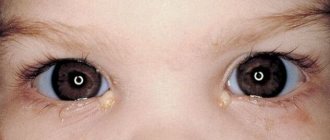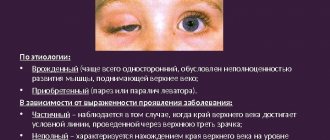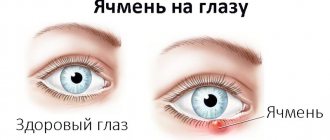What is blenorrhea?
Blennorea is an inflammatory process of the eye mucosa that requires immediate treatment. It can occur in both adults and infants. In the first case, these are the consequences of a sexually transmitted infection, in the second, the baby becomes infected while passing through the birth canal.
The infection is common gonorrhea, which can be acquired both through sexual contact and through household items shared with a sick person. A patient with ordinary gonorrhea can easily infect himself with blenorrhea without following the rules of hygiene; it is enough to transfer the microorganism from the genitals to the eyes.
Despite how scary this disease looks, it goes away quite easily in infants. An adult experiences the disease much worse, both in terms of symptoms and consequences. Blindness as a result of blenorrhea is unlikely, but other, less serious visual impairments occur frequently.
Now the statistics on infantile gonoblenorrhea are almost reduced to zero, modern maternity hospitals carry out prevention and stop the development of the pathology in time if the microbe is present. Mothers also undergo a thorough check and the responsible doctor knows in advance about the presence of sexually transmitted diseases in their bodies.
Useful video
Nystagmus, review, symptoms, diagnosis, treatment, prevention:
Causes of blenorrhea
There is only one way to get such an unpleasant disease, get gonorrhea or encounter an infected person. Most people know gonorrhea (or gonorrhea, as it is popularly called) as a sexually transmitted disease that does not affect anything other than the genitourinary tract, but this is not entirely true. The bacterium gonococcus, which is the causative agent of gonorrhea, can also develop in the mucous membrane of the eye.
Usually the bacterium does not come into contact with the mucous membranes of the eyes for obvious reasons. Most people wash their hands after urinating, but there are exceptions. As soon as gonococcus enters the eye, it immediately initiates an inflammatory process.
You can get infected in only two ways:
- due to non-compliance with sanitary and hygienic standards (infection comes from the patient himself),
- due to contact with the personal belongings of an infected person, which contain particles of urine and other secretions of the genitourinary system, for example, with a bath sponge (gonococcus gets first onto the hands and then into the eye).
In women, the incubation period for gonorrhea is longer, so a pregnant woman may well become infected and not immediately understand it. If there are any signs of the disease, the expectant mother is entitled to treatment, and the child will now be under control from the first days of life, so doctors will identify symptoms in time, if they appear, and prevent the disease.
Gonococcal conjunctivitis in infants
Gonoblenorrhea in newborns, like gonorrhea itself, has been practically eradicated with the help of sex education, the help of venereologists, as well as regular checks and preventive measures in maternity hospitals.
Having discovered the first signs in a child, doctors quickly eliminate the disease, but even if it has managed to reach the purulent stage, there is no need to seriously fear for the baby’s vision. Problems can only arise if the child’s treatment is delayed.
How does infection occur in infants?
A newborn is at risk of becoming infected with gonococcus, as it passes through the birth canal, which is part of the genitourinary system, where gonococcus lives if a woman has gonorrhea. Such a danger is possible only in the case of natural childbirth.
This information is not common among expectant mothers due to lack of awareness. There is a strong belief that sexually transmitted infections can only be transmitted sexually, but in fact, any contact with the mucous membrane of the genital organs and microparticles of urine risks illness.
Also, the baby has no immunity at all, so for him even fleeting contact of the surface of the eye or eyelids with the tissues of the mother can have such consequences. To prevent this from happening, many preventive measures have been developed, which are effective in most cases.
Treatment of the disease
Injection antibiotics can be used to treat the disease.
General and local therapy is aimed at destroying the pathogen and lasts approximately 2 weeks. In addition to the pediatrician and ophthalmologist, a dermatovenerologist participates in complex treatment. The acute course of blenorrhea requires the systemic use of antibacterial drugs. A repeat smear is also taken to determine the effectiveness of the therapy. Main events:
- Regular (every 1-1.5 hours) jet cleansing of the conjunctival cavity with saline solution.
- The use of an antibacterial drug for eye drops or intramuscular injection.
- Placing antimicrobial ointment behind the eyelids.
- Use a protective bandage for a healthy eye for preventive purposes.
Drugs
Rinsing the eye mucosa is carried out with solutions of sodium chloride, Furacilin, and potassium permanganate. After the cleansing procedure, the eyes are instilled with sulfonamide or antibacterial agents - Albucid, Tetracycline, Penicillin. In case of exacerbation, antibiotics are prescribed by injection. In case of damage to the cornea, antimicrobial liniments are used, including erythromycin ointment or containing tetracycline.
Folk recipes
A decoction of sage can be used to treat a child’s visual organs.
Treatment of blenorrhea is recommended to be supplemented with the use of herbal decoctions. The most effective are chamomile, sage, and calendula. The affected eyes are washed with decoctions several times during the day to remove purulent plaque. The use of such products speeds up recovery, as the plants have an antibacterial and disinfectant effect. One of the ways to prepare a medicinal drug:
- Pour 1 tbsp. l. flowers with 200 ml water.
- Boil.
- Leave in a thermos for 40-50 minutes.
- Filter through 2-3 layers of gauze.
- Wash your eyes with the decoction or apply compresses.
Symptoms
The symptoms of gonoblennorrhea are difficult to confuse with anything else. The disease, also called gonococcal conjunctivitis, quickly manifests itself with extremely frightening symptoms. If nothing is done in time, gonoblennorrhea affects the cornea.
Signs of illness in newborns:
- redness of the eyelids,
- daily increasing swelling of the eyelids,
- difficulty for an adult to open a baby’s eyes even with his fingers,
- gray-bloody discharge from the eye (in the first stages),
- purulent discharge of a standard white or light yellow color.
Important! If you notice at least one of these symptoms in a child, you should immediately seek help from your doctor. The nearest pediatrician and ophthalmologist will help prescribe medication.
Consequences of pathology
Children suffer from this disease more easily and quickly than adults, but this does not mean that complications cannot occur. They do not occur, since the newborn is under constant supervision of neonatologists and obstetricians, who can easily recognize gonococcus as soon as they notice symptoms. Neglected gonoblennorrhea can lead to dire consequences, the formation of a purulent corneal ulcer.
Do not forget that this is primarily an infection. If you give the infection the opportunity to multiply without preventing it in any way, without giving antibiotics, it will constantly bother the baby until it reaches the stage of more serious diseases. Low oxygen availability, difficulty in processing and constant formation of new fluid are ideal conditions for corneal ulceration. In the future, it can lead to partial blindness, turning into a thorn.
In addition, gonoblennorrhea, like any acute infectious conjunctivitis, is very contagious. The parent inevitably comes into contact with the child, so he becomes the first candidate for the same disease. A sick baby is very dangerous for other children in the family, especially small ones.
Now, in a modern maternity hospital or with adequate parents, this is an absolute rarity. No hospital will allow a child under observation to suffer from gonoblennorrhea.
Blennorea
The clinical picture of neonatal blenorrhea usually develops 2-3 days after birth; with intrauterine infection, the child is born with signs of severe conjunctivitis. In children, both eyes are usually affected; if infection occurs after childbirth, the eyes can be involved in inflammation sequentially.
Blennorea begins with the appearance of hyperemia and edema of the conjunctiva, swelling and redness of the eyelids. The child's eyelids are so dense that they can hardly be turned out or opened; The conjunctiva bleeds easily when touched. During this period of blenorrhea (period of infiltration), scanty discharge of a serous-hemorrhagic nature is noted from the conjunctival cavity.
After 3-4 days, the eyelids soften, an abundant thick purulent secretion begins to be released from the palpebral fissure, which accumulates on the eyelashes, sticks them together, and flows down the skin of the cheeks. The period of suppuration with blenorrhea lasts 2-3 weeks. Following this, in the development of blenorrhea, a period of papillary hypertrophy begins, which is characterized by a decrease in the amount of pus, a weakening of the severity of edema and hyperemia of the conjunctiva. Papillary growths, follicles and folds appear on the mucous membrane of the eyelids. During the recovery stage, the conjunctiva gradually takes on its normal appearance.
With a favorable outcome of blenorrhea, the formation of conjunctival scars is not observed. After a severe form of blenorrhea, which occurs with ulceration of the mucous membrane, scarring of the conjunctiva and eversion of the eyelids may be observed. In the most malignant cases of blenorrhea, damage to the cornea occurs - its maceration and infection, malnutrition due to compression of the marginal looped network in the thickness of the limbus by edema. In this case, the cornea looks dull due to the formation of a limited grayish-yellow infiltrate. Subsequently, the infiltrate quickly disintegrates with the formation of a purulent corneal ulcer.
The outcome of this condition with blenorrhea may be resorption of the infiltrate, epithelization of the ulcer with residual superficial opacification of the cornea. If the development of the ulcerative process is unfavorable, a rough leukoma (thorn) is formed, fused with the iris. If the purulent process penetrates into the internal structures of the eye, blenorrhea can be complicated by endophthalmitis and panophthalmitis, followed by atrophy of the eyeball.
Blennorrhea in adults begins with damage to one eye, but in almost all cases it is more severe than blenorrhea in newborns. Symptoms of blenorrhea in adults are more pronounced; severe complications develop more often.
Non-gonococcal blenorrhea usually has a milder course than the gonococcal form. Clinically, it is similar to other bacterial conjunctivitis. With chlamydial damage to the eyes (chlamydial conjunctivitis), otitis media, pneumonia, and lymphadenitis often develop.
Diagnostics
The disease is noticed during examination; usually the problem becomes visible before the baby begins to experience discomfort. An examination of the eye of a sick child must be carried out in special clothing, a mask and glasses. This is necessary to protect against pus, which is released almost continuously and can get on the doctor.
Usually the disease cannot be confused with anything, but to exclude more serious diseases, a sample is taken from the conjunctiva, which is later studied in the laboratory for the presence of pathogens of various pathologies.
Treatment methods
Because infants have significantly limited treatment options compared to adults, doctors can only do the following: observe to prevent complications, wash the eyes regularly to prevent pus from accumulating, and treat the infection with medication. On average, you can get rid of the disease in a week or a few.
Washing
It is this simple symptom-control method that the infant needs most. Due to his age, he is not even able to try to alleviate his condition, so adults (medical staff or parents at home) should wash both eyes, even if only one is affected, as needed. Usually this is once every 1-2 hours.
Head of the ophthalmology clinic. An ophthalmologist with more than 10 years of experience. Rinsing with running water is not enough; after such treatment, the discharge will quickly return, and irritation with itching and pain will not disappear. Antibiotic solutions are used for effective treatment. Depending on the degree of infection of the mucous membrane, different drugs are used (adjustment of drug treatment also occurs with an emphasis on the infant’s possible individual intolerance to certain drugs). Antibacterial agents are effective because they have a beneficial effect on the condition of the eye mucosa in the long term, and also alleviate the child’s condition in fact.
Injections
Contact of the antibiotic directly with the affected tissue (eye mucosa) is very effective, but it is advisable to combine it with injections. Most often, an infant is injected with ordinary pennicillin, but it is also enough to strengthen the antibacterial barrier.
Due to the fact that infants easily tolerate such therapy, gonoblennorrhea is eliminated in the vast majority of cases. Complications are possible only if the parents discovered the disease at home and did not seek qualified help, getting rid of the infection on their own.
Prevention and treatment of gonoblennorrhea
For the prevention and treatment of gonoblennorrhea in newborns, a 30% solution of sodium sulfacyl (albucid) is currently used. After the birth of the child, even before separating him from the mother, a dry sterile cotton ball is used to remove vernix and mucus from the skin of the newborn’s eyelids, and then one drop of albucide solution is instilled into the conjunctival sac with a sterile pipette. For girls, albucid is also instilled into the genital opening. After 2 hours, the procedure is repeated. Each newborn is instilled with a separate pipette.
The first toilet of a newborn In the maternity room or in a specially equipped children's room, everything necessary for the first toilet of a newborn should be provided: a set of sterile linen, instruments and individual sterile care items in accordance with the instructions. The midwife performs the first toilet for the newborn. Before proceeding with the toilet, she again treats her hands according to the method indicated above, then cleanses the child’s skin of vernix, mucus and blood using a soft gauze pad soaked in sterile Vaseline or vegetable oil.
In cases of severe contamination of the child, with infected amniotic fluid, or if the mother has a genital infection during pregnancy or childbirth, it is recommended to give the newborn a hygienic (cleansing) bath with a pink solution of potassium permanganate (1:10,000) at a water temperature of 37-38 ° C. However, this procedure should last no more than 2-3 minutes.
If the condition of the skin of a newborn is unsatisfactory (pyoderma), the child is given a bath with a decoction of oak bark, after which the natural folds of the skin are treated with zinc paste, and the remaining surface of the skin is treated with a 1% solution of chlorophyllipt in 100 ml of glycerin. Subsequently, the newborn’s skin is lubricated only with this mixture 3-4 times a day. After the first toilet and treatment of the skin, the newborn is weighed, his height, head and chest circumference are measured, a designated oilcloth bracelet is attached to his wrist, then the child is wrapped in sterile warm diapers and a blanket.
A medallion is tied on top of the blanket indicating the same data as on the bracelet: last name, first name, patronymic of his mother, date and hour of birth, gender and weight of the child, birth history number. The child, wrapped in sterile linen, remains in the children's room of the maternity unit on a heated changing table for 2 hours, after which he is transferred to the ward of the neonatal department.
“Care, nutrition and vaccine prevention of a child”, F.M. Kitikar
Caring for a baby in the neonatal ward
After transfer from the maternity ward to the neonatal ward, the child is carefully examined by a pediatrician or children's nurse. If necessary, treat the child's skin again. Using a sterile cotton ball moistened with petroleum jelly, remove the remaining vernix lubrication, then lubricate the natural folds of the skin with a thin layer of 1% tannin ointment. The main functions of medical personnel in the neonatal department are proper organization and...
Caring for the remaining umbilical cord
The child’s face and eyes are washed daily with sterile cotton swabs soaked in boiled water or a weak pink solution (1:8000) of potassium permanganate. To treat the eyes of newborns, it is better to use a solution of furatsilin (1:5000). Treat the eyes with separate swabs, from the outer corner of the eye to the inner. The oral mucosa should not be wiped, as it is easily injured. You should also not clean...
Newborn clothes
Clothes intended for a newborn should protect him from significant heat loss, be spacious and not restrict movement, and not interfere with maintaining physiological posture. The fabric should not irritate the child’s skin and interfere with free evaporation from the outer surface of the skin. These requirements are best met by a vest and a blouse without any buttons or fasteners. On the clothes of children in the first months of life...
Dressing and swaddling a newborn
First, the child is carefully dressed in a thin vest, the sleeves of which must be closed tightly, which ensures better heat retention and prevents accidental injury to the child’s face and eyes due to uncoordinated movements of the hands. A flannel blouse is worn over a vest. The vest and blouse are wrapped loosely at the back, all folds are carefully smoothed out with your hands. In the summer, they wear only one thin blouse...
Envelope
Head covering and swaddling along with arms should be performed on full-term infants only on the first day of life. The rest of the time, when swaddling, the head is left open and the hands are free. The swaddled newborn is placed in an envelope made of cotton fabric, into which a soft flannelette blanket is placed in winter and a cotton blanket in summer. If necessary, during the cold season, place on top of the envelope...
Prevention
Gonoblenorrhea is not a rare disease in newborns. The infection has never been an epidemic, but it occurs often enough that a preventive program has been developed against it, comprehensively consisting of diagnostics of the expectant mother, medications and treatment of the eyes of newborns immediately after birth. This program is followed in all maternity hospitals in the Russian Federation.
Intrauterine prophylaxis
There is no preventive effect on the fetus itself; the expectant mother is checked for the presence of an infectious agent. The test does not specifically concern gonorrhea, but is part of a set of tests for the presence of various viruses that can further harm the baby or even affect the course of intrauterine development.
If, for example, a mother is diagnosed with gonorrhea, she will be offered emergency treatment, the result of which is an almost one hundred percent guarantee that the baby will not become infected when passing through the birth canal.
Prevention in the delivery room
To try to eliminate a possible infection immediately after birth, obstetricians resort to a simple but effective measure. The process of cleaning the newborn immediately after birth and primary medical procedures (removal of the umbilical cord and primary vitality checks) includes wiping the eyelids with boric acid (2% solution).
Later, the child, regardless of the presence of signs of the disease, is given lapis solution (silver nitrate) in both eyes. These preventive measures are absolutely harmless to the child, but do not lead to a 100% effect.
Before being discharged home
Before discharging a child from the hospital, staff must ensure that the newborn does not suffer from any diseases, and also do everything to prevent diseases typical of infants. To prevent the remaining infection from reactivating and harming the baby, before discharge, the eyes are treated several times with sodium sulfacyl solution, drip method, 1-2 drops in each eye.
First days at home
After discharge from the maternity hospital, the baby becomes entirely the responsibility of the parents. Their task is not only to eliminate existing diseases, but also to prevent all possible ones. Proper care of a baby's eyes will save him not only from gonoblennorrhea, but also other infectious eye diseases, mainly other forms of acute conjunctivitis.
The baby’s washing procedure is necessary both to get rid of dirt particles, and also to moisturize the eyes artificially (newborns do not immediately become able to truly cry). It is up to the parent to improve it so as to eliminate the possibility of infection or reduce the likelihood to a minimum.
What to do:
- Stock up on sterile and high-quality supplies for children's hygiene, good cotton swabs. It is not recommended to use ordinary cotton wool and cheap tampons; fibers can separate from the lump of the former and get into the eye, and the latter do not have a soft enough structure for delicate skin.
- Learn the correct wiping technique; you need to walk along the entire length of the eyelids from the inner corner to the outer. You shouldn’t press too hard, but you shouldn’t be afraid to press too much, otherwise it’s pointless.
- If they were prescribed in the maternity hospital or in the pediatrician's office, you need to instill medications into already clean eyes. Even if you have to drip frequently, you shouldn’t be lazy to wipe your eye once again before taking the medicine. Under no circumstances should you use the same cotton swab more than once.
If there are several children in the family, parents should be especially careful. There is no need to go too far with prevention, for example, placing children in different rooms, but contacts should also be stopped. If the children are the same age or their age difference does not exceed a year or two, you need to differentiate between the things used to care for them. Even those things that are not needed for eye care or similar purposes, the baby can touch, and then put his hands with the infection into his eye.
By following these simple rules, as well as other sanitary and hygienic standards for handling the baby, parents do everything possible to prevent infection. If the disease still intensifies, you cannot continue independent therapy; you should immediately contact your pediatrician for individual recommendations and a prescription for antibiotics. Infectious conjunctivitis cannot go away on its own; after days and weeks of inactivity it will only get worse, since by removing the symptoms, it is impossible to influence the disease itself.
Useful video
Diseases of the lacrimal ducts: what is the danger of self-medication? Review, symptoms, diagnosis, treatment, prevention:
Blennorrhea in newborns: causes, symptoms and treatment
Blennorea is a purulent inflammation of the conjunctiva of the eye caused by microbial flora.
This pathology is accompanied by hyperemia and swelling of the eyelids, purulent discharge from the eyes. In rare cases, with an unfavorable course, it is possible to develop a purulent ulcer of the cornea of the eye, a cataract, and in severe cases, panophthalmitis.
The main direction of treatment is copious rinsing of the conjunctival cavity, instillation of antimicrobial drugs, and systemic antibiotic therapy.
Blenorrhea in newborns is an acute purulent-inflammatory disease involving the conjunctiva of the eye in the pathological process. Depending on the pathogen, gonoblenorrhea (gonorrhea of gonococcal etiology) and blenorrhea of non-gonococcal etiology are distinguished. Gonoblenorrhea in newborns is currently quite rare due to its planned prevention in maternity hospitals.
Causes of blenorrhea in newborns
The causative agent of blenorrhea in newborns is most often gonococcus, but in a third of cases microorganisms such as pneumococci, streptococci, E. coli, and mixed flora are identified in culture cultures. The causative agent may also be chlamydia trachomatis, a microorganism that causes trachoma; Usually this pathogen acts in association with gonococcus.
The development of blenorrhea in newborns is associated with the entry of microorganisms into the mucous membrane of the child’s eyes during the birth process when the fetal head passes through the birth canal.
Less common is intrauterine infection with blenorrhea during prolonged, difficult labor or premature opening of the amniotic sac.
Postpartum infection is also possible when a child becomes infected through dirty hands, care items, or water if hygiene rules are not followed.
Symptoms of blenorrhea
Signs of blenorrhea in newborns develop on days 2-3 of life. If intrauterine infection occurs, the symptoms of blenorrhea are determined from the moment of birth. In most cases, both eyes are affected, but if the infection occurs after childbirth, the eyes are involved in the pathological process sequentially.
Symptoms of blenorrhea are hyperemia and swelling of the conjunctiva, swelling and redness of the eyelids. At the same time, the baby’s eyelids are so dense that it is difficult to open them. The conjunctiva bleeds easily when touched. At the initial stage (during the period of infiltration), the discharge from the eyes is scanty, serous-hemorrhagic.
After 3-4 days, the child’s eyelids become softer, an abundant purulent thick secretion is released from the palpebral fissure, accumulating on the eyelashes and gluing them together. The discharge flows down the skin of the cheeks. This period (suppuration) can last 2-3 weeks.
Next, the stage of papillary hypertrophy develops: the amount of pus decreases, the severity of edema and hyperemia of the conjunctiva decreases. Papillary growths, folds, and follicles appear on the conjunctiva of the eyelids.
During the recovery period, the conjunctiva gradually takes on its normal appearance.
With a favorable course of the disease and timely treatment, scars do not form on the conjunctiva. In severe forms of pathology with ulceration of the mucous membrane, scarring of the conjunctiva with eversion of the eyelids is possible.
In the most severe cases, infection and maceration of the cornea develops, a violation of its trophism due to compression of the marginal looped network by edematous tissues in the thickness of the limbus. The cornea appears dull due to the formation of a limited gray-yellow infiltrate in it.
The infiltrate subsequently disintegrates and a corneal ulcer forms. In this case, the outcome may be epithelization of the defect with persistent superficial opacification of the cornea or the formation of a rough leioma (cataract) fused to the iris.
If the purulent process penetrates into the internal structures of the eye, endophthalmitis and panophthalmitis develop, in which case death and atrophy of the eyeball is possible.
Blenorrhea in newborns of non-gonococcal nature usually has a milder course and is clinically similar to other conjunctivitis of bacterial etiology. With chlamydial etiology of the process, the development of otitis media, lymphadenitis, and pneumonia is possible.
Diagnosis of blennorrhea
During the initial examination, if a newborn has blenorrhea, it is already possible to identify the first signs of purulent conjunctivitis and even suspect the etiology of the disease.
During the examination, when the edges of the eyelids are pulled apart, purulent secretion is separated.
During an eye examination, the doctor must use protective glasses and isolate the patient's eyelids with cotton swabs, since if there is a large accumulation of secretion when the eyelids are pulled apart, it can spray out in a stream.
To determine the exact flora and prescribe optimal treatment, a bacteriological examination of the discharge and PCR diagnostics are performed. When identifying blenorrhea in children, parents also need to be examined.
To exclude damage to the deep structures of the eyeball, eye biomicroscopy, diaphanoscopy, and fluorescein instillation test may be required.
Treatment of blenorrhea in newborns
Treatment of blenorrhea includes local therapy and general measures aimed at eliminating the causative agent of the pathology.
Frequent jet rinsing of the conjunctival sac is necessary (every hour and a half) with saline solution, furatsilin, a weak solution of potassium permanganate, after which antimicrobial eye drops (albucid, penicillin and others) are instilled.
At night, antimicrobial ointments (erythromycin, tetracycline) are placed behind the eyelids. A protective bandage is applied to the healthy eye to prevent infection.
In severe cases of blenorrhea, systemic administration of antibacterial drugs is prescribed: more often antibiotics are administered intramuscularly. The duration of complex therapy is about two weeks. Next, repeated bacteriological seeding of the contents of the conjunctival cavity is performed to monitor the effectiveness of therapy.
With non-gonococcal etiology of benorrhea in newborns, the prognosis is favorable. In the case of gonococcal lesions, there is a high probability of complications, including blindness.
Prevention of blenorrhea in newborns
The basis for the prevention of benorrhea in newborns is the examination of a pregnant woman for sexually transmitted infections and timely treatment of colpitis, urethritis, and bartholinitis. To prevent gonoblennorrhea in newborns after birth, antibacterial drops are instilled into the conjunctival sac.
Moscow clinics (TOP-3), where they treat blenorrhea in newborns
- Clinic of Dr. Shilova T.Yu.
- Moscow Eye Clinic
- MNTK named after S.N. Fedorov
All eye clinics in Moscow >>>
Blennorrhea in newborns: causes, symptoms and treatment
Source: https://prokonyuktivit.ru/blennoreia-y-novorojdennyh-prichiny-simptomy-i-lechenie.html
